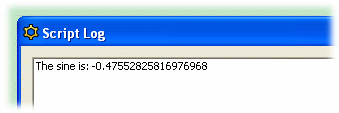A DataHub script has complete
access to all the data in the DataHub. Every point in the DataHub
is available in Gamma as a global variable, with the syntax:
The dollar sign character ($) tells Gamma
that the colon is part of the variable name. A colon in
Gamma is normally a syntactic element and can't be used in a
variable name. However, the DataHub uses a colon
(:) in point names to separate the domain
name from the rest of the point name. So we need to use the
dollar sign. The dollar sign is not part of the variable
name.
![[Note]](images/note.gif) | For these examples, ensure
that the DataSim
program is running and connected to the
DataHub. |
Access a Value
Once
To start with, here's how to read a
value one time.
- Create a new script with a class named
AccessData, selecting
Allow only one instance. Here's how.
Scroll down to the .constructor
method, and enter the following:
method AccessData.constructor ()
{
princ("The sine is: ", $DataSim:Sine, "\n");
}- Make sure the DataSim program is running, and that
the Script Log is
open so you'll be able to see the script output.
Click the blue
arrow icon

in the Script Editor toolbar. You
should see a value appear in the Script Log window, like
this:
- Click the blue arrow icon several more times. Each
time, a new value should appear in the Script Log. The
values will differ because the value for the sine wave in
DataSim is constantly changing.
Access Values
Continuously
Getting a single value from
the DataHub is fine, but we can do much better. Let's print each
new value from a point every time it changes.
First you should move the princ
statement out of the
.constructor. This may seem
trivial in this example, but it is a good habit to get
into. Move the princ statement to
the AccessData.sample method, and
edit the method name and princ
statement to look like this:
method AccessData.print_point (pt)
{
princ("The sine is: ", pt, "\n");
}Edit the .constructor
method like this:
method AccessData.constructor ()
{
.OnChange(#$DataSim:Sine,
`(@self).print_point($DataSim:Sine));
}The
OnChange method is
inherited from the parent class,
Application.
This method is a wrapper for the
on_change
function, which tells Gamma to evaluate an expression when
a given symbol changes value. In this case, the symbol is
$DataSim:Sine and the expression
is our
print_point function. The first
expression is protected from evaluation by the
# quote
operator.
The second expression is also
quoted so that it doesn't run until the point actually
changes. However, the
self that is
usually understood must be explicitly written and evaluated
so that Gamma knows what the
.print_point method applies to.
Therefore, we use the
` and
@ quote
operators.
Click the blue arrow icon

in the Script Editor toolbar.
A new value gets written twice a second. To see it
really fly, bring up the DataSim window, click the
More button, and change the
Update Frequency to 200 (don't forget
to click Apply Changes). To make
it stop, click DataSim's Pause
button.
But what if you can't stop the data flow? How do
you get the princ function to
stop?
Stop Accessing
Values
Often you will want a script's
change functions to stop when the class instance is destroyed.
Conveniently, the Application class has a
destructor that runs any time a child class gets destroyed,
and which removes all OnChange
functions. One way to destroy the instance of class is with a
timer.
![[Note]](images/note.gif) | The timer is used here for
demonstration purposes. Most Windows programs get destroyed
by clicking a button or some other means. |
Go to .constructor
method and adding the following code:
after(3, `destroy(@self));
This uses Gamma's
after timer
function, which in this case will activate 3 seconds after
the instance is constructed and cause the instance to
destroy itself. Again, to prevent the
destroy
function from being evaluated and destroying our instance
prematurely, we have to quote it. And again, we use the
` and
@ quote operators to evaluate
the
self argument. After 3 seconds, the
destroy function will be evaluated,
and the instance gets destroyed.
Your two methods should now look like this:
method AccessData.print_point (pt)
{
princ("The sine is: ", pt, "\n");
}
method AccessData.constructor ()
{
.OnChange(#$DataSim:Sine,
`(@self).print_point($DataSim:Sine));
after(3, `destroy(@self));
}- Run the script. You should see output in the Script
Log for 3 seconds, then nothing.
Verify Results
To verify that the instance of the class has been
destroyed, type
instance_p(_AccessData_Singleton) in
the text entry field at the bottom of the Script Log and
press Enter. The output should look like
this:
--> instance_p(_AccessData_Singleton);
nil
The
instance_p function is a
Gamma
predicate that
checks to see if
accessdata is an
instance. Gamma returns
nil, indicating
that it is not an instance.
Since accessdata was an
instance and is no more, it is probably a destroyed
instance. To check, type
destroyed_p(_AccessData_Singleton); and
press Enter. The output should look like
this:
--> destroyed_p(_AccessData_Singleton);
t
Gamma returns
t, indicating
that it is a destroyed instance.


![[Note]](images/note.gif)
 in the Script Editor toolbar. You
should see a value appear in the Script Log window, like
this:
in the Script Editor toolbar. You
should see a value appear in the Script Log window, like
this:
 in the Script Editor toolbar.
in the Script Editor toolbar. ![[Note]](images/note.gif)